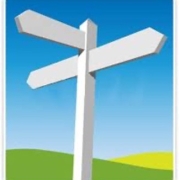Location, location, or a signpost to trouble?
One thing most authors agree about is the need for accuracy when describing their locations – but just how far can you go in pinpointing exact street names and addresses? A bit of caution, and common sense, is often needed.
For example, it’s all very well describing a car chase through Lower Manhattan or London’s East End but beware having your drug baron or child kidnapper pull up outside a precisely numbered house in a precisely identifiable street! Think of the poor sod who just happens to live there!
It won’t do either to try to get around the issue by saying something like “midway along the terrace” or “at the far end of the street” because, you’ve guessed it, there’s another poor sod living there too!
Google Earth makes it easy for authors to show off their locational knowledge by undertaking a virtual tour before describing it to readers. But somewhere along the journey the author will have to use a little license to invent a new turn-off into a new-name street that doesn’t exist. That way at least the bad guy can park up safely at whatever house he likes.
Who cares that a reader who just happens to live in the area knows that the last stage of the journey is an invention – better that than having to reply to a lawsuit from Joe Bloggs who is convinced that your mention of his address as a crack house has seriously intruded on his privacy!
Some authors go too far to avoid the pitfalls. There are numerous well-known writers who invent strange new towns and zip codes to ensure they don’t point the finger unintentionally at an innocent bystander. In my opinion, that goes too far – unless you happen to be dreaming up scenes for the television series Midsomer Murders where the collection of made-up towns and villages adds greatly to the charm of the stories. Where we would be without Midsomer Parva or Morton Fendle or Elverton-cum-Latterly?
The Midsomer series, notwithstanding, the job of the author is to make his/her locations as accurate as possible. Readers expect to be informed and treated like adults when they take the trouble to spend their hard-earned cash. They know going in what to expect by way of realism – there’s no need to add insult to injury. Readers know there has to be some locational ‘tweaking’ – for the same reasons they don’t expect to read the exact mobile phone numbers or car registrations belonging to real people.
It’s all about balance. One great trick for authors is to describe a setting they know intimately and then transpose it to wherever their story happens to be based – this tends to work better for rural scenes than for urban areas, but the principle is the same.
If, for example, an author is describing a derelict industrial site outside Chicago he/she doesn’t actually have to drive to Chicago to be able to capture the essence of the place. Rundown industrial sites, with dilapidated warehouses, can be regrettably found anywhere in the world. Pick the one you know and go with it.
Accuracy, however, is everything. Authors who have never been to Ireland, and have failed to do their research, need to know that when you drive out of Newry (in Northern Ireland) you have only to travel a few hundred yards (a bit of license here!) to cross an invisible border into an entirely different country (the Republic of Ireland).
While many believe it should be regarded as the one-island country of Ireland (the key to our troubled past!) the author needs to keep a factual perspective.
But I digress. Readers of modern-day fiction don’t want to be taken on a tour around Neverland with a collection of fantasy town names that will assuredly spoil their enjoyment of the story. Keep it factual, keep it realistic, and only stray into the world of make-believe locational names when you absolutely have to zoom into someone’s house on someone’s street.
If you’ve ever come across a bad example of the use of a location, I’d love to hear about it.





Leave a Reply
Want to join the discussion?Feel free to contribute!